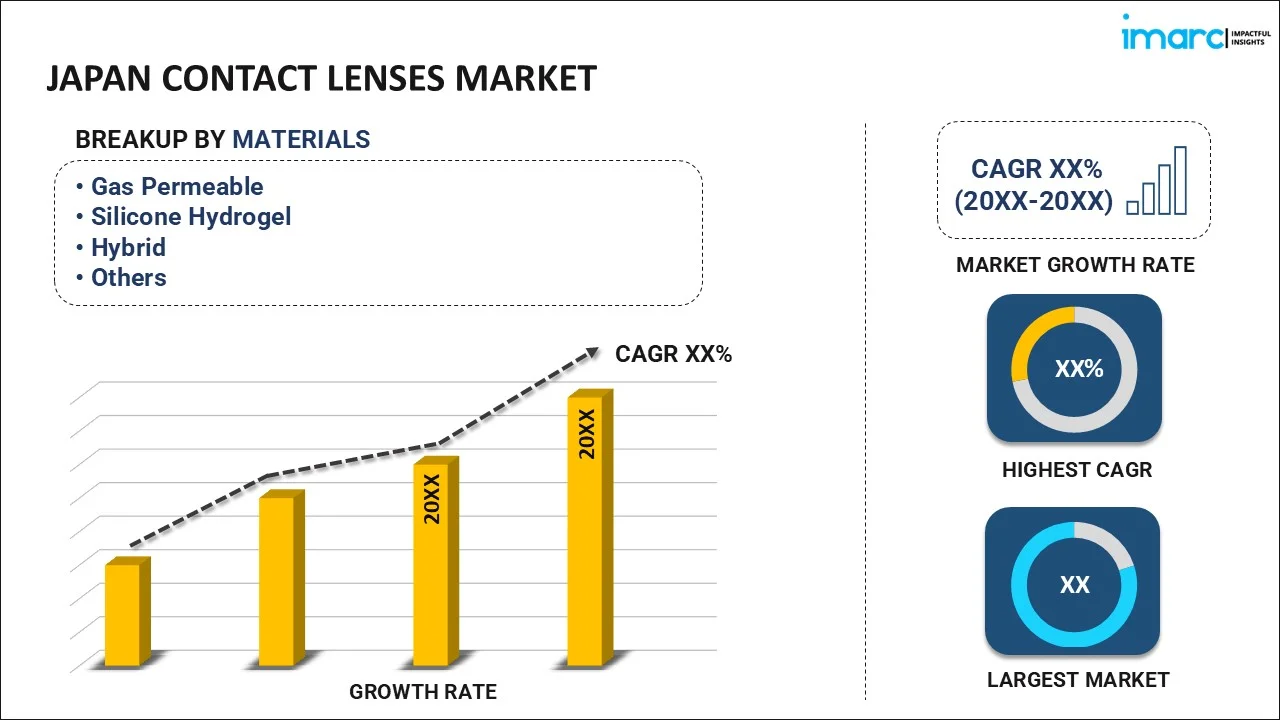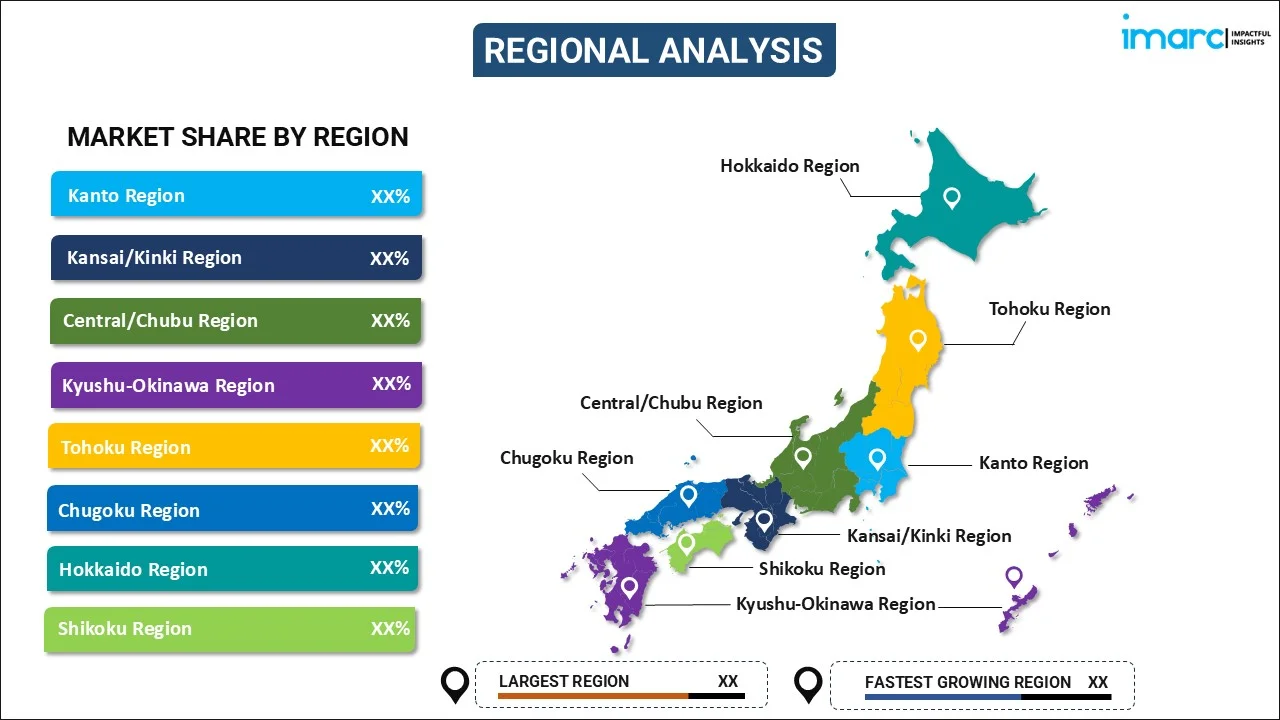
Japan Contact Lenses Market Report by Material (Gas Permeable, Silicone Hydrogel, Hybrid, and Others), Design (Spherical, Toric, Multifocal, and Others), Usage (Daily Disposable, Disposable, Frequently Replacement, Traditional), Application (Corrective, Therapeutic, Cosmetic, Prosthetic, Lifestyle-oriented), Distribution Channel (E-commerce, Eye Care Practitioners, Retail Stores), and Region 2026-2034
Market Overview:
Japan contact lenses market size reached USD 409.6 Million in 2025. Looking forward, IMARC Group expects the market to reach USD 643.6 Million by 2034, exhibiting a growth rate (CAGR) of 5.15% during 2026-2034. The increasing incidences of visual inaccuracies, along with the rising inclination among individuals towards more dynamic and aesthetically appealing alternatives to eyeglasses, are primarily driving the market growth.
|
Report Attribute
|
Key Statistics
|
|---|---|
|
Base Year
|
2025
|
|
Forecast Years
|
2026-2034
|
|
Historical Years
|
2020-2025
|
| Market Size in 2025 | USD 409.6 Million |
| Market Forecast in 2034 | USD 643.6 Million |
| Market Growth Rate 2026-2034 | 5.15% |
A contact lens is a slim, shaped lens designed to rest directly on the eye's outer layer. Crafted from high-quality polymers, they are utilized to rectify vision issues, for aesthetic reasons, or to offer therapeutic protection to the eye. These lenses are carefully constructed to comfortably sit on the cornea, hovering over the layer of tears. They serve as a substitute for eyeglasses, granting users an expanded visual range and adaptability, particularly useful during physical endeavors. Various versions of contact lenses are available in the market, such as soft, hard, gas-permeable, long-duration wear, single-use, and lenses with unique effects. Each variety is tailored to meet specific user needs, whether it's fixing vision discrepancies, altering the eye's hue, or boosting wear comfort.
Japan Contact Lenses Market Trends:
The Japan contact lens market is witnessing a surge, primarily propelled by the growing incidence of vision disorders like myopia, hypermetropia, astigmatism, and presbyopia. Additionally, technological strides, such as the introduction of silicone hydrogel lenses and the emergence of intelligent, connected lenses, are enhancing wearability and ease for the user, thereby bolstering market progression. Besides this, changing societal norms and the allure of tinted lenses are also steering consumer preference towards contact lenses, overshadowing traditional spectacles. What's more, heightened consciousness about ocular health, complemented by the ubiquitous presence and accessibility of eye care facilities, is aiding market expansion. Furthermore, the rise in disposable income paired with the impact of fashion inclinations is prompting increased expenditure on contacts, adding momentum to market dynamics. Continuous technological ingenuity is refining contact lenses, elevating their comfort, functionality, and appeal, catering to a diverse demographic. Specifically, the advent of silicone hydrogel lenses has markedly improved oxygen transmissibility, promising a healthier and more agreeable extended wear experience. Concurrently, the innovative creation of smart lenses, embedded with sensors to gauge intraocular tension or sugar concentrations, denotes a monumental evolution in medical optics, further amplifying the market's trajectory in Japan.
Japan Contact Lenses Market Segmentation:
IMARC Group provides an analysis of the key trends in each segment of the market, along with forecasts at the country level for 2026-2034. Our report has categorized the market based on material, design, usage, application, and distribution channel.
Material Insights:

- Gas Permeable
- Silicone Hydrogel
- Hybrid
- Others
The report has provided a detailed breakup and analysis of the market based on the material. This includes gas permeable, silicone hydrogel, hybrid, and others.
Design Insights:
- Spherical
- Toric
- Multifocal
- Others
A detailed breakup and analysis of the market based on the design have also been provided in the report. This includes spherical, toric, multifocal, and others.
Usage Insights:
- Daily Disposable
- Disposable
- Frequently Replacement
- Traditional
The report has provided a detailed breakup and analysis of the market based on the usage. This includes daily disposable, disposable, frequently replacement, and traditional.
Application Insights:
- Corrective
- Therapeutic
- Cosmetic
- Prosthetic
- Lifestyle-oriented
A detailed breakup and analysis of the market based on the application have also been provided in the report. This includes corrective, therapeutic, cosmetic, prosthetic, and lifestyle-oriented.
Distribution Channel Insights:
- E-commerce
- Eye Care Practitioners
- Retail Stores
The report has provided a detailed breakup and analysis of the market based on the distribution channel. This includes e-commerce, eye care practitioners, and retail stores.
Regional Insights:

- Kanto Region
- Kansai/Kinki Region
- Central/ Chubu Region
- Kyushu-Okinawa Region
- Tohoku Region
- Chugoku Region
- Hokkaido Region
- Shikoku Region
The report has also provided a comprehensive analysis of all the major regional markets, which include Kanto Region, Kansai/Kinki Region, Central/ Chubu Region, Kyushu-Okinawa Region, Tohoku Region, Chugoku Region, Hokkaido Region, and Shikoku Region.
Competitive Landscape:
The market research report has also provided a comprehensive analysis of the competitive landscape in the market. Competitive analysis such as market structure, key player positioning, top winning strategies, competitive dashboard, and company evaluation quadrant has been covered in the report. Also, detailed profiles of all major companies have been provided.
Japan Contact Lenses Market Report Coverage:
| Report Features | Details |
|---|---|
| Base Year of the Analysis | 2025 |
| Historical Period | 2020-2025 |
| Forecast Period | 2026-2034 |
| Units | Million USD |
| Scope of the Report | Exploration of Historical Trends and Market Outlook, Industry Catalysts and Challenges, Segment-Wise Historical and Future Market Assessment:
|
| Materials Covered | Gas Permeable, Silicone Hydrogel, Hybrid, Others |
| Designs Covered | Spherical, Toric, Multifocal, Others |
| Usages Covered | Daily Disposable, Disposable, Frequently Replacement, Traditional |
| Applications Covered | Corrective, Therapeutic, Cosmetic, Prosthetic, Lifestyle-oriented |
| Distribution Channels Covered | E-commerce, Eye Care Practitioners, Retail Stores |
| Regions Covered | Kanto Region, Kansai/Kinki Region, Central/ Chubu Region, Kyushu-Okinawa Region, Tohoku Region, Chugoku Region, Hokkaido Region, Shikoku Region |
| Customization Scope | 10% Free Customization |
| Post-Sale Analyst Support | 10-12 Weeks |
| Delivery Format | PDF and Excel through Email (We can also provide the editable version of the report in PPT/Word format on special request) |
Key Questions Answered in This Report:
- How has the Japan contact lenses market performed so far and how will it perform in the coming years?
- What has been the impact of COVID-19 on the Japan contact lenses market?
- What is the breakup of the Japan contact lenses market on the basis of material?
- What is the breakup of the Japan contact lenses market on the basis of design?
- What is the breakup of the Japan contact lenses market on the basis of usage?
- What is the breakup of the Japan contact lenses market on the basis of application?
- What is the breakup of the Japan contact lenses market on the basis of distribution channel?
- What are the various stages in the value chain of the Japan contact lenses market?
- What are the key driving factors and challenges in the Japan contact lenses?
- What is the structure of the Japan contact lenses market and who are the key players?
- What is the degree of competition in the Japan contact lenses market?
Key Benefits for Stakeholders:
- IMARC’s industry report offers a comprehensive quantitative analysis of various market segments, historical and current market trends, market forecasts, and dynamics of the Japan contact lenses market from 2020-2034.
- The research report provides the latest information on the market drivers, challenges, and opportunities in the Japan contact lenses market.
- Porter's five forces analysis assist stakeholders in assessing the impact of new entrants, competitive rivalry, supplier power, buyer power, and the threat of substitution. It helps stakeholders to analyze the level of competition within the Japan contact lenses industry and its attractiveness.
- Competitive landscape allows stakeholders to understand their competitive environment and provides an insight into the current positions of key players in the market.
Need more help?
- Speak to our experienced analysts for insights on the current market scenarios.
- Include additional segments and countries to customize the report as per your requirement.
- Gain an unparalleled competitive advantage in your domain by understanding how to utilize the report and positively impacting your operations and revenue.
- For further assistance, please connect with our analysts.
 Request Customization
Request Customization
 Speak to an Analyst
Speak to an Analyst
 Request Brochure
Request Brochure
 Inquire Before Buying
Inquire Before Buying




.webp)




.webp)












